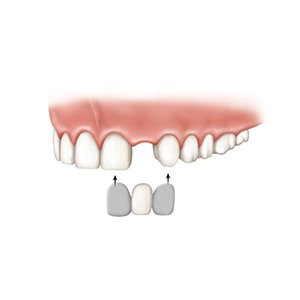Bridges
Dental bridges replace missing teeth and teeth that are too badly damaged for crowns or fillings. They help hold remaining teeth in proper alignment and keep natural teeth from bearing too much stress from biting and chewing. This is one of the most common dental procedures for filling a gap in a patient’s smile.
Dental bridges are a commonly recommended treatment for replacing one or more missing teeth with realistic prosthetics. Although adult tooth loss in the U.S. is decreasing overall, a high percentage of people do lose one or more teeth to gum disease, cavities or fracture at some point. According to the National Institute of Dental and Craniofacial Research, adults lose an average of one-to-two permanent teeth (not counting wisdom teeth) before the age of 50.


TRADITIONAL DENTAL BRIDGE
A traditional bridge requires the presence of a healthy tooth on either side of the gap to support the prosthesis. This bridge consists of three crowns that are all attached to each other. The crown in the middle is actually called a “pontic” and is the prosthetic that replaces the missing tooth. The two on either side are regular crowns that fit over existing teeth called the abutment teeth. Porcelain and porcelain fused to metal (PFM) are the most common materials used for these dental bridges.

CANTILEVER DENTAL BRIDGE
This type of bridge is similar to a traditional bridge. However, it is used when there is no support tooth available on one side of the missing tooth (e.g., with a missing back molar). Instead, two crowns are placed directly next to each other and the pontic is on the end. Some cantilever bridges use only one crown plus the pontic.

RESIN BONDED DENTAL BRIDGE
This type of bridge uses metal bands and dental bonding resin to attach a pontic to adjacent teeth. The metal bands are positioned on the backside of the support teeth to make them less noticeable. This approach does not require extensive preparation of the adjacent teeth, since they do not receive crowns. A resin bonded or “Maryland” bridge is sometimes used for restoring front teeth.
WANT TO LEARN MORE?
DROP US A NOTE.
Please fill out the form below and someone from our team will get back to you as soon as possible.
CLAXTON FAMILY DENTISTRY
Office Address
201 E. Long Street, Claxton, GA 30417
Phone
(912) 739-1595
info@claxtonfamilydentistry.com
Fax
912-739-1557
